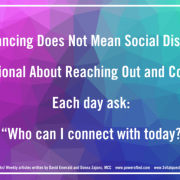Amidst the current COVID-19 global pandemic, workers from across sectors and industries are finding themselves telecommuting from their homes. While “working from home (WFH)” has been a rising trend among “knowledge workers” and self-employed “gig workers” in tech-centered industries, for many this is a first in their career. Organizations large and small are trying to grasp the new challenges this creates as we are all forced to disperse and hunker down.
Below are a few essentials to keep in mind as we all try to navigate WFM during this moment:
Keep (or build) a routine. With everyone’s fears and anxieties rising about unknowns in the present and future, it’s more important than ever to keep consistency as a way of finding comfort and familiarity in ever changing circumstances. WFH may feel liberating at first. For many it means saving time from that long commute or space away from difficult colleagues or a flurry of distractions in the office. However, if we do not stick to and master the basics, we can quickly begin to feel like everything is spinning out of control.
That extra time that you find in your morning from not having to commute does not have to be dedicated to sleeping in. Just because this newfound freedom and flexibility allows you to “roll” from your bed to the first conference call of the day, does not mean it is sustainable for your mental wellness or performance. Also, no one wants to see you in your pajamas on the Zoom meeting.
If you were a hard-charging, early riser with a solid exercise regimen and personal development rituals, then stick to it and refine it for new circumstances! If you have struggled to build a consistent routine, now is the perfect time to use that savings in the morning and afternoons to invest in yourself. Start with small, achievable goals and incrementally build your way towards them. Use this time to build long-lasting habits.
Create a space for success! Part of keeping a sense of normalcy is ensuring that you have a workspace at home that enables you to succeed. You do not want to find yourself slinking down on the couch every morning with your smartphone while your spouse or roommate streams Netflix in front of you.
If you do not already have a functional home office or library, try to find another space in your home that is private, quiet, well-lit, and allows you to stay organized. Try to avoid (if possible) places like the dining room table or bedroom that are dedicated for relaxation. You do not want your unfinished work staring at you over dinner or wake-up first thing to it! Ideally, you want a space that at the end of the workday you can shut down, unplug, and close the door to.
If your living quarters are limited in space or if you have multiple persons competing for quiet space to work, get creative. Invest in noise-cancelling headphones or earplugs or create temporary dividers. Anything that enables you to focus and separates your work from your personal life.
Communication. Right now, everyone is feeling the pressure. Many homes have more than one adult and possibly school-aged children under one roof, all trying to get things done. It’s very important that everyone is open and honest about their needs are and aware that there are competing priorities all around us. Members of the same household should try regular meetings to deconflict schedules and priorities. Through this dialogue, a couple might decide that one spouse should watch the children, while the other works for a set period of time and then trade off. Whatever you work out, prepare to be flexible as circumstances rapidly shift.
As a member of a team at your place of employment, you should also be regularly communicating the challenges you are facing from home and your proposed solutions. This could mean everyone working on a staggered schedule or taking a longer lunch break to go for a walk with family. In order for that to work, everyone needs to be clear what the goals and priorities are for the organization as a whole.
If you are a leader in the organization, be conscious of everyone’s collective anxiety, especially with an uncertain public health and economic forecast. Be prepared to constantly communicate and reinforce your intent to others. Try to set reasonable goals for the team to meet. Old metrics for productivity may not be possible to measure right now. Instead of looking at things from a “9 to 5” hours-worked perspective, take a 360 view of the organization and what needs to happen to weather this storm. Try to measure success by tasks complete, not time in chairs or constant emailing. Instead of routine assignments, use this time to invest in professional development or long-term projects that are often deprioritized during regular periods such as finding new markets and product lines or implementing new technology for process improvement.
A few great reads for learning how to lead teams through complex circumstances is Team of Teams by Stanley McCrystal and One Mission by Chris Fussell. Emphasized in both books is the importance of leaders communicating their intent throughout their organization including to geographically dispersed teams. Both provide excellent case studies and tested tools to implement within your organization.


 TED*
TED* 




